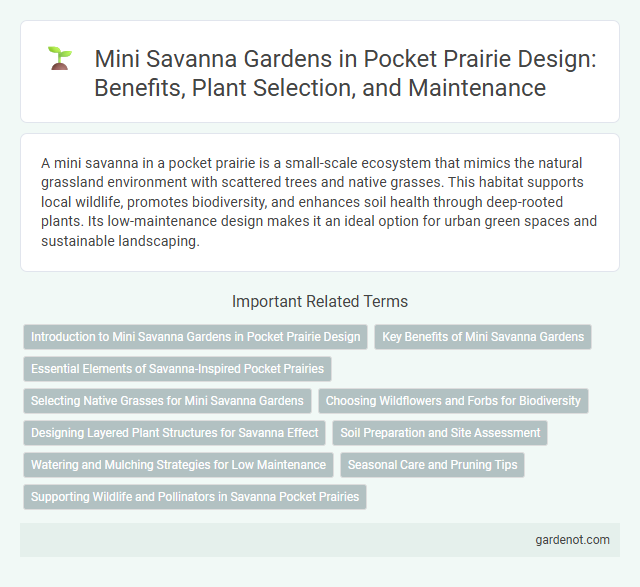A mini savanna in a pocket prairie is a small-scale ecosystem that mimics the natural grassland environment with scattered trees and native grasses. This habitat supports local wildlife, promotes biodiversity, and enhances soil health through deep-rooted plants. Its low-maintenance design makes it an ideal option for urban green spaces and sustainable landscaping.
Introduction to Mini Savanna Gardens in Pocket Prairie Design
Mini savanna gardens in Pocket Prairie design recreate the diverse ecosystems of natural savannas by incorporating native grasses, wildflowers, and shrubs adapted to local climates. These compact ecosystems support pollinators, enhance soil health, and require minimal maintenance, making them ideal for urban and suburban landscapes. Integrating mini savanna elements promotes biodiversity and resilience while providing aesthetic value in sustainable garden settings.
Key Benefits of Mini Savanna Gardens
Mini savanna gardens promote biodiversity by providing habitat for native pollinators and wildlife, enhancing local ecosystems. These compact ecosystems require minimal maintenance while supporting drought-resistant plants, making them ideal for sustainable urban landscaping. Mini savanna gardens also improve soil health and aid in carbon sequestration, contributing to environmental resilience.
Essential Elements of Savanna-Inspired Pocket Prairies
Mini savanna pocket prairies replicate the essential elements of traditional savannas by incorporating diverse native grasses, wildflowers, and scattered trees to create a balanced ecosystem. These pocket prairies optimize biodiversity, support pollinators such as bees and butterflies, and promote soil health through deep-rooted plants. Strategic layering of herbaceous plants and woody species mimics natural savanna structure, ensuring sustainability and resilience in urban green spaces.
Selecting Native Grasses for Mini Savanna Gardens
Selecting native grasses for mini savanna gardens enhances biodiversity and ensures ecological harmony by promoting local wildlife habitats. Species such as Little Bluestem (Schizachyrium scoparium), Indian Grass (Sorghastrum nutans), and Switchgrass (Panicum virgatum) thrive in pocket prairie conditions due to their drought tolerance and deep root systems. These native grasses stabilize soil, support pollinators, and create the layered structure characteristic of authentic mini savanna ecosystems.
Choosing Wildflowers and Forbs for Biodiversity
Selecting diverse wildflowers and forbs such as purple coneflower, black-eyed Susan, and butterfly milkweed enhances the mini savanna's biodiversity by attracting pollinators like bees and butterflies. Incorporating native species ensures adaptability to local soil and climate conditions, promoting resilience and ecological balance. A mix of early, mid, and late blooming plants extends the flowering season, supporting wildlife throughout the growing period.
Designing Layered Plant Structures for Savanna Effect
Designing layered plant structures in a mini savanna involves selecting a diverse mix of grasses, shrubs, and trees that mimic natural savanna ecosystems. Emphasizing vertical stratification enhances biodiversity and creates microhabitats, supporting pollinators and small wildlife. Key species such as little bluestem (Schizachyrium scoparium), purple coneflower (Echinacea purpurea), and redbud trees (Cercis canadensis) establish a dynamic, resilient landscape with seasonal interest.
Soil Preparation and Site Assessment
Mini savanna pocket prairies thrive on well-prepared soil characterized by loose, nutrient-rich loam with good drainage and a pH between 6.0 and 7.0, optimizing root development and plant health. Detailed site assessment includes evaluating sunlight exposure, existing vegetation, and soil compaction to determine the suitability for native grasses and wildflowers typical of savanna ecosystems. Effective soil preparation involves clearing invasive species, tilling to a depth of 6-8 inches, and incorporating organic amendments to enhance microbial activity and nutrient availability.
Watering and Mulching Strategies for Low Maintenance
Mini savanna pockets benefit from deep, infrequent watering to encourage deep root growth and drought resilience. Applying a 2-3 inch layer of organic mulch, such as wood chips or shredded leaves, helps retain soil moisture and suppress weeds. This low-maintenance approach supports healthy plant establishment while reducing irrigation frequency.
Seasonal Care and Pruning Tips
Mini savannas in pocket prairies require seasonal care to maintain their ecological balance and plant health. Prune native grasses and wildflowers during late winter or early spring to remove dead material and encourage vigorous growth. Regularly monitor moisture levels and adjust watering schedules to support drought-resistant species typical of these habitats.
Supporting Wildlife and Pollinators in Savanna Pocket Prairies
Mini savanna pocket prairies provide essential habitat for native wildlife and pollinators such as bees, butterflies, and birds by offering diverse native plant species rich in nectar and pollen. These small-scale savannas enhance biodiversity, support migratory pathways, and contribute to ecosystem resilience in urban and suburban areas. Establishing native grasses and flowering plants in mini savannas promotes sustainable wildlife populations and improves pollination services critical for local flora reproduction.
Mini savanna Infographic

 gardenot.com
gardenot.com